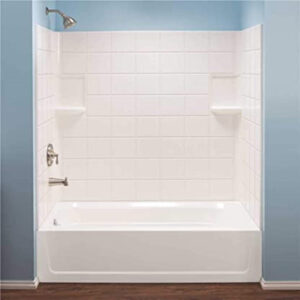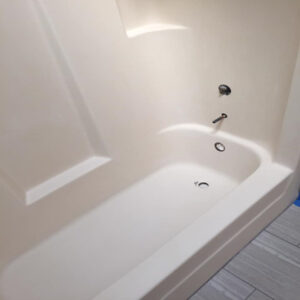Cleaning the bathtub need not be too difficult or troublesome. You only need the right tools and cleaning products, many of which are good for the environment. Therefore, before dipping your toes into the dirty bathtub, let us look at some important tips for cleaning fiberglass tub.
- Confirm that it is glass fiber
It can be tile, slate, porcelain, acrylic, fiberglass or enamel. The last four look similar, but you can distinguish them by looking closely… and there is a refrigerator magnet.
Acrylic is what looks like “plastic”. Natural stone, even if polished, does not shine like fiberglass, while porcelain is heavier and shorter because it has a cast iron base.
Although the bottoms of porcelain basins and tubs do have metal, they have been completely replaced, so they do not respond to magnets. However, refrigerator magnets can easily stick to your enamel walls, so this is a good “tell”. Regardless of whether it is made of spray-sprayed materials, the use of harsh chemicals should be avoided.
- Identify stains
Unlike other common shower and bathtub materials, glass fiber is made of melted sand, processed at high temperature, and then mixed with resin. Like all tubs, it accumulates mold, limescale, rust and stains caused by acidic beauty products.
Soap scum is another hazard in the bathroom. Because soap has a greasy oil base, the puddles and spills it forms can be stubborn when it accumulates. A typical soap is made by treating fats with high-pressure steam, then purifying, distilling, and adding alkali to it.
Other items that may stain fiberglass tubs include cosmetics, hair care products, spilled medicines, bath bombs, washing powder, toilet sprays and children. The latter are their own special category because they can invade the bathroom with anything, from crayons to cookie crumbs.
- Wipe while it is hot
Many bathtub stains are caused by dirt residues from sebum, cleaning products and organic dust. This is why wet bathrooms are easier to clean. Heat and water vapor will soften fatty dirt, so a lot of fatty dirt will be wiped off immediately. But not everyone scrubs the walls after showering
Another way is to run the shower for two to five minutes in the hottest conditions. This makes the shower more beautiful, which means you need less elbow grease. You can also choose to heat the cleaning solution in the microwave for a minute or two. But be careful if it is a foam cleaner!
- Avoid polishing pads
Pour a soft sponge into a bucket of warm soapy water, and then gently scrub the surface of the fiberglass bathtub. If you are not using a soft sponge, make sure that your applicator is made of nylon, polyester or polyurethane.
Do not use scouring pads, steel wool or scrapers, as they will be too rough on the glass fiber. Avoid using abrasive cleaning products, such as scouring powder, as they can damage the fiberglass bathtub or shower
- Keep away from bleach
Bleach will destroy the resin in the fiberglass, so you don’t want to rub it on the bathtub or shower wall.
Ammonia is safe on glass fiber, so it is a viable option. This is particularly good at removing watermarks. But be careful, inhaling excessive ammonia is as bad as inhaling bleach, so dilute the ammonia with plenty of water and make sure the room is well ventilated.
- Use white vinegar
The mild acid is great for absorbing most oily dirt found in showers. White vinegar is a popular choice. Mix some water and warm water in a spray bottle, and then sprinkle it on the steam sprayed wall. Let it sit for ten minutes to half an hour, depending on how dirty your shower is.
Then, you can run the shower again to wet the mess and wipe off all the debris. Vinegar is especially useful for shower heads or ordinary shower heads. Fill the plastic bag with vinegar and tie it to the shower head with shoelaces or rubber bands. overnight.
- Mix vinegar (or baking soda) with dishwashing liquid
When ordinary vinegar does not solve the problem, add a few drops of mild dishwashing liquid, such as Dawn or Morning Fresh. You can replace white vinegar with any mild household acid, such as apple cider vinegar or hydrogen peroxide. Dish soap will increase the foam in the soap.
The foam is good because its bubbles can loosen stains and pull dirty dust particles to the surface, you can easily wipe them off. If your household acid runs out, try spraying warm water mixed with a few drops of dishwashing liquid. The longer it sits, the better the cleaning effect.
When you don’t use vinegar, another combination is to mix dishwashing liquid with one or two teaspoons of baking soda. It makes the mixture more abrasive, so you can wipe off dirty stains without scratching the glass fiber surface. Rub using circular motions.
- Mix the vinegar with baking soda
You don’t want to scrub the fiberglass wall or scratch the shower door because it will leave scratches. Therefore, try to make an abrasive paste by mixing vinegar and baking soda. The thicker the paste, the better the effect. But mixing large batches is unrealistic.
Therefore, make about a quarter or half cup of paste, apply it directly to the stain, and leave it for a longer time as needed. From 30 minutes to all night. Wipe it in if necessary. After setting, rinse with clean water or wipe with damp cloth.
- Rinse with gentle cold water
Once the cleaning material you choose has achieved the desired effect, run the shower again to generate clean steam. Then, you can use a hand shower, garden hose or spray bottle filled with water to soak the wall. Warm rinse will loosen all oily residue.
Then rinse off all soap with cold water. Then, to prevent watermarks from appearing, wipe the walls with a clean, soft, lint-free cloth. Microfiber works best. Finally, run the bathroom fan or open the windows to expel any humid air and prevent the accumulation of moisture and mold.






























